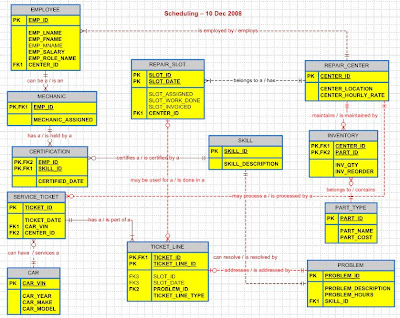ER Diagram Of Inventory Management System depicts the major concepts and relationships needed for managing inventory resources. It is neither a complete data model depicting every necessary relational database table, nor is it meant to be a proscriptive design for implementations of resource management systems.
Alternate models may capture the necessary attributes to relationships and represent the schemas or the overall organization of the system. In order to begin constructing the basic model, the modeler must analyze the information gathered during the requirement analysis for the purpose of :
• Classifying data objects as either entities or attributes,
• Identifying and defining relationships between entities,
• Naming and defining identified entities, attributes, and relationships,
• Documenting this information in the data document.
• Finally draw its ER diagram.
An entity is an object (generally correspond to persons, objects, group, locations, place, events, an activity, etc. Examples are employee, vendor, supplier, materials, warehouse, delivery, etc.) about which data is stored. An occurrence is a single instance of an entity; for example, a particular 19-inch color TV set is a single occurrence of the entity called Inventory. An attribute is a property of an entity; for example, such attributes as stock number, description, and stock on hand might be associated with Inventory. Generally, the same set of attributes is associated with each occurrence of an entity, so every part in Inventory can be expected to have a stock number, a description, and a stock on hand. The set of attributes associated with an entity can be visualized as a table or a record : It represents a collection of objects or things in the real world whose individual members or instances have the following characteristics :
1. Each can be identified uniquely in some fashion.
2. Each plays a necessary role in the system we are building.
3. Each can be described by one or more data elements (attributes).
There is one possible source of confusion about the ER Diagram Of Inventory Management System that might need clarification. A specific 19-inch color TV set is an example of a single occurrence of that entity, but Inventory might hold 100 or more virtually identical TV sets. For Inventory control purposes, tracking TV sets (a class of occurrences) is probably good enough. However, a Customer purchases a specific TV set (identified, perhaps, by concatenating the serial number to the stock number). Thus a given Item sold lists one and only one occurrence of Inventory.
Entity keys are used to uniquely identify instances of entities. Attributes having unique values are called candidate keys and one of them is designated as primary key. The domains of the attributes should be pre-defined. If 'name' is an attribute of an entity, then its domain is the set of strings of alphabets of predefined length.
There are five types of entities for ER Diagram Of Inventory Management System
1. Fundamental entity: It does not depend on any other entity for its existence. For e.g. materials
2. Subordinate entity: It depends on another entity for its existance. For example, in an inventory management system, purchase order can be an entity and it will depend on materials being procured. Similarly invoices will depend on purchase orders.
3. Associative entity: It depends on two or more entities for its existence. For example, student grades will depend on the student and the course.
4. Generalisation entity: It encapsulates common characteristics of many subordinate entities. For example, a four wheeler is a type of vehicle. A truck is a type of four wheeler .
5. Aggregation entity: It consists of or an aggregation of other entities. For example, a car consists of engine, chasis, gear box, etc. A vehicle can also be regarded as an aggregation entity, because a vehicle can be regarded as an aggregation of many parts.
Logically, the relationship can be stated in the form of a sentence with a verb linking the two entities; for example, Sales transactions are composed of Products or Products make up Sales transactions. The act of creating such sentences is a good test of the relationship’s validity; if you can’t express the link, it might not exist. In most cases where the relationship is unclear, the sentence might be written alongside the relationship line.
*The Entity Relationship (ER) Model, proposed by Peter Chen in 1976, has been proven to be one of the most popular and powerful tools to do enterprise data modeling, serving as the blueprint of the database, shows graphically the business model of the enterprise.




